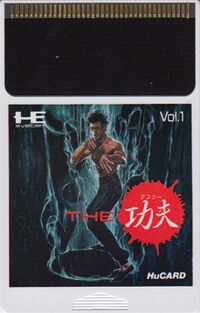Difference between revisions of "HuCard"
From NEC Retro
(Created page with "thumb|right|200px|A HuCard of ''[[The Kung Fu'', one of the first commercially available HuCards.]] The '''HuCard''' (ヒューカード), a...") |
MarioSonicU1 (talk | contribs) |
||
| (One intermediate revision by one other user not shown) | |||
| Line 18: | Line 18: | ||
Populous PCE JP Card.jpg|The front of a JP ROMRAM HuCard of ''[[Populous]]'', with a noticeably thicker shell. | Populous PCE JP Card.jpg|The front of a JP ROMRAM HuCard of ''[[Populous]]'', with a noticeably thicker shell. | ||
Populous PCE JP Card Back.jpg|The back of a JP ROMRAM HuCard of ''[[Populous]]''. | Populous PCE JP Card Back.jpg|The back of a JP ROMRAM HuCard of ''[[Populous]]''. | ||
| − | BonksAdventure TG16 US Card.jpg|The front of a US | + | BonksAdventure TG16 US Card.jpg|The front of a US TurboChip of ''[[Bonk's Adventure]]''. |
| − | BonksAdventure TG16 US Card Back.jpg|The back of a US | + | BonksAdventure TG16 US Card Back.jpg|The back of a US TurboChip of ''[[Bonk's Adventure]]''. |
| + | Granzort SGX JP Card.jpg|The front of a SuperGrafx HuCard of ''[[Madou Ou Granzort]]''. | ||
| + | Granzort SGX JP Card Back.jpg|The back of a SuperGrafx HuCard of ''[[Madou Ou Granzort]]''. | ||
</gallery> | </gallery> | ||
Latest revision as of 18:42, 2 July 2024

The HuCard (ヒューカード), also known in North America and Europe as the TurboChip, is the primary storage medium for PC Engine, TurboGrafx-16 and PC Engine SuperGrafx games.
Design
The design of the HuCard follows after the "Bee Card", which Hudson Soft had initially designed for MSX computers. While card-based storage mediums have already been attempted with video game systems such as Sega's My Cards, HuCards were designed to house larger ROM sizes than prior contemporaries, with the first HuCards supporting 2 megabits (256 kB) and later HuCards supporting sizes as big as 8 megabits (1 MB).
The PCB of a HuCard is stored in the black area of the card, which has 38 connector pins and varies in size depending on the storage capacity, and is inserted into a console face-up - the rest of the card is merely plastic and shows the sticker that is exposed when the card is in use, while the back side of the card typically has safety instructions printed on it as well as a space for the user to write their name with a waterproof pen. Due to their flat design, HuCards were shipped in specially-designed jewel cases much like those used for CDs.
However, some HuCards may have additional hardware in the sticker area of the HuCard to contain additional hardware, such as further increasing the ROM size to 20 megabits (2.5 MB), at the expense of being slightly thicker than regular HuCards. These are known as "ROMRAM HuCards" on the back. The only games known to contain additional hardware in the sticker area are Street Fighter II': Champion Edition and Populous.
HuCards were not just used to store software, but also for certain peripherals, such as the Ten no Koe Bank which also comes in a "ROMRAM HuCard" containing a CR2032 battery to retain save data, and System Cards which are used to contain the boot ROM as well as additional hardware to run software designed for CD-ROM² systems.
Official HuCard designs
The front of a JP HuCard of The Kung Fu, a 2-megabit game.
The front of a JP HuCard of PC Genjin 2, a 4-megabit game.
The back of a JP HuCard of PC Genjin 2.
The front of a JP ROMRAM HuCard of Populous, with a noticeably thicker shell.
The back of a JP ROMRAM HuCard of Populous.
The front of a US TurboChip of Bonk's Adventure.
The back of a US TurboChip of Bonk's Adventure.
The front of a SuperGrafx HuCard of Madou Ou Granzort.
The back of a SuperGrafx HuCard of Madou Ou Granzort.
Unofficial HuCard designs
The front of a Games Express CD Card.
The back of a Games Express CD Card.










